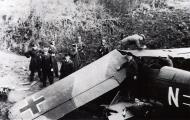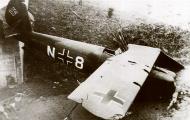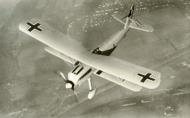Ar 68E1 10.(N)JG72 based in Mannheim autumn 1939 0A
Arado Ar 68F1 10.JG72 red N1 Oedheim Heilbronn Sep 1939 01
Arado Ar 68F1 10.JG72 red N1 Oedheim Heilbronn Sep 1939 02
Arado Ar 68F1 10.JG72 red N1 Oedheim Heilbronn Sep 1939 0A
Arado Ar 68F1 10.JG72 red N1 Oedheim Heilbronn Sep 1939 0B
Arado Ar 68F 10.(Nacht)/JG 72 (N1) Oedheim-Heilbronn Sep 1939 0A
Profile 00: Arado Ar-68F-1 red (N+1) of 10.(Nacht)/JG72, Oedheim/Heilbronn, September 1939 This aircraft was camouflaged in an uppersurface splinter pattern of 70/71 which extended well down the sides of the fuselage to meet a permanent black where the original 65 undersurfaces had been overpainted. Note the propeller blades are light grey on the fiont faces but black on the rear and that the national insignia on the uppersurface of the mainplane were either toned down or completely overpainted.
Arado Ar-68F-10.(Nacht)/JG 72 red (N1) Oedheim-Heilbronn Sep 1939 01-02
Photo’s 01-02: Photographs of Arado Ar-68F-1 JG72.10 Red (N+1) at Oedheim-Heilbronn, September 1939
Arado Ar-68F-1 10.(Nacht)/JG72 white (N8) crashed in Germany 1940 01-02
Photo’s 01-02: These two views of another Ar-68F of 10.(Nacht)/JG72 which crashed in south-west Germany in 1940 clearly show the splinter pattern on the uppersurfaces, but this time apparently in 71 and 02.
Photo 01: This photograph of Bf-109D-1s of 11.(Nacht)/JG2 was taken shortly after the German invasion of Norway in April 1940, and shows sailors of the Kriegsmarine with one of the Staffd's aircraft at Oslo Fornebu.
Emblem of 10 (Nacht)/JG72
On May 1939, a single-engined night fighter Staffel was created with the formation of 10.(Nacht)/JG2 and in September, 11.(Nacht)/JG2 was formed by redesignating 10.(Nacht)/LG2. Also in September, a further single-engined night fighter Staffel was formed with the creation of 10.(Nacht)/JG26, but this was redesignated 12.(Nacht)/JG2 in December to form a full Gruppe, the IV(Nacht)/JG2, equipped with the Ar 68 F and the Bf 109 D-1. These early, single-engined night fighter units existed only for a short time before being disbanded or absorbed by the day fighter force. Note that the Ar-68 Fs (FAR RIGHT) were sometimes fitted with an early type of flame damper, shown more clearly (RIGHT). Although the Pik As, or Ace of Spades emblem, has led to the assumption that this aircraft belonged to JG53, it is believed that it was in fact operated by 10.(Nacht)/JG72, which had been formed in July 1939 from personnel of II./JG53. In February 1940, 10.(N)/JG72 was redesignated 12.(Nacht)/JG2 before finally becoming 6./NJG1 in June 1940. A similar emblem but showing an owl on a branch was sometimes employed by 11.(Nacht)/JG2.
| Role: Biplane Fighter |
| Manufacturer: Arado |
| Designer: Walter Blume |
| First flight: 1934 |
| Introduction: 1936 |
| Retired: 1944 |
| Primary user: Luftwaffe |
| Number built: 511 |
| Crew: one |
| Length: 9.5 m (31 ft 2 in) |
| Upper wingspan: 11 m (36 ft 1 in) |
| Lower wingspan: 8 m (26 ft 3 in) |
| Height: 3.3 m (10 ft 10 in) |
| Aspect ratio: 6.1 |
| Empty weight: 1,600 kg (3,527 lb) |
| Gross weight: 2,020 kg (4,453 lb) |
| Fuel capacity: main tank:200 l (53 US gal; 44 imp gal); oil tank:27 l (7.1 US gal; 5.9 imp gal) |
| Powerplant: 1 × BMW VI V-12 liquid-cooled piston engine, 541 kW (725 hp) |
| Propellers: 2-bladed wooden fixed pitch propeller, 3.1 m (10 ft 2 in) diameter |
| Performance |
|---|
| Maximum speed: 330 km/h (210 mph, 180 kn) at sea level |
| Landing Speed: 97 km/h (60 mph; 52 kn) |
| Range: 500 km (310 mi, 270 nmi) |
| Service ceiling: 7,400 m (24,300 ft) |
| Rate of climb: 12.6 m/s (2,480 ft/min) |
| Time to altitude: 6,000 m (19,685 ft) in 16 minutes |
| Wing loading: 74 kg/m2 (15 lb/sq ft) |
| Armament |
| Guns: 2 × 7.92 mm (0.312 in) MG 17 machine guns with 500 r.p.g. (rounds per gun) |
| Bombs: Up to 6x 10 kg (22 lb) SC 10 fragmentation bombs |
The Arado Ar 68 was a German single-seat biplane fighter developed in the mid-1930s. It was among the first fighters produced when Germany abandoned the restrictions of the Treaty of Versailles and began rearming.
Design and development
Designed to replace the Heinkel He 51, the Ar 68 proved to have admirable handling characteristics on its first flight in early 1934, despite Arado's inability to secure a sufficiently powerful engine for the prototype. Eventually, a Junkers Jumo 210 was installed and the Ar 68 went into production, though not before worries about the unforgiving nature of such a high-performance aircraft almost resulted in the cancellation of the project.
The Ar 68 entered service with the Luftwaffe in 1936 and one of the first units was stationed in East Prussia. Soon, the fighter was sent to fight in the Spanish Civil War, where it was outclassed by the Soviet Polikarpov I-16. Arado responded by upgrading the engine of the Ar 68E, which soon became the Luftwaffe's most widely used fighter in 1937–38, before being replaced by the Messerschmitt Bf 109. The last Ar 68s served as night fighters up to the winter of 1939–40, after which they served as fighter-trainers until 1944.
Ar 68V1: Prototype, powered by a 492 kW (660 hp) BMW VI engine. First flight in 1934.
Operators
Ar 68a: First prototype. 1 x 478 kW (641 hp) BMW VId V-12.
Ar 68b: Second prototype. 1 x 455 kW (610 hp) Jumo 210A inverted V-12.
Ar 68c: Third prototype. 1 x 455 kW (610 hp) Jumo 210A inverted V-12.
Ar 68d: Fourth prototype. 1 x 478 kW (641 hp) BMW VId V-12.
Ar 68 V4: The fourth prototype (Ar 68d), redesignated after the RLM (Reichs Luftfahrtministerium) introduced the standardised Versuchs (research) number system.
Ar 68e: Fifth prototype. 1 x 507 kW (680 hp) Jumo 210Da inverted V-12.
Ar 68 V5: The fifth prototype (Ar 68e), redesignated after the RLM introduced the standardised Versuchs (research) number system.
Ar 68E: First type to enter Luftwaffe service, powered by a 455 kW (610 hp) Junkers Jumo 210, at sea level for 5 minutes, 500 kW (671 hp) at 3,800 m (12,467 ft).
Ar 68F: Interim production, powered by a BMW VI 7.3Z; 559 kW (750 hp) at sea level for 1 minute, 410 kW (550 hp) at 1,000 m (3,281 ft), awaiting supply of Jumo 210 engines.
Ar 68G: Abortive attempt to fit a supercharged 500 kW (671 hp) BMW VI.
Ar 68H: Only a single prototype was built, powered by a 634 kW (850 hp) BMW 132Da 9-cyl. supercharged air-cooled radial. It was also the first Arado fighter to have an enclosed cockpit.Germany: Luftwaffe
Spain: Spanish Air Force
Warnemünde Germany Map
Mosjoen harbor Norway Map
Citations: +
- Horst H. Geerken (9 June 2017). Hitler's Asian Adventure. BoD – Books on Demand. pp. 375–376. ISBN 978-3-7386-3013-8.
- Sivertsen 1999: 105, 115–122
- Sivertsen 1999: 122
- Kotelnikov, V. Stalin's Captives article in Fly Past magazine, February 2017 pp102-4
- Frank Joseph, The Axis Air Forces: Flying in Support of the German Luftwaffe, ABC-CLIO, 2011, p. 166
- Smithsonian: National Air and Space Museum: Arado Ar 196
- HCWinters (12 June 2013). 'USA leihen Arado an das MFG aus'. Cuxhavener Nachrichten.
- 'Kriegsflugzeug kehrt nach Deutschland zurück'. Die Welt.
- Bardanis, Manolis; Lino, von Garzten. 'Die Geschichte der Arado 196 von Herakleaia' (PDF). naxosdiving.com. Naxos Diving.
- Sharpe, Michael. Biplanes, Triplanes, and Seaplanes Airplanes, pg.41. London, England: Fruriedman/Fairfax Books, 2000. ISBN 1-58663-300-7.
- Green, William (1970). Warplanes of the Third Reich (1st ed.). New York: Doubleday n Company Inc. pp. 28–31. ISBN 0 385 05782 2.
Bibliography: +
- Dabrowski, Hans-Peter and Koos, Volker. Arado Ar 196, Germany's Multi-Purpose Seaplane. Atglen, PA: Schiffer Publishing, 1993. ISBN 0-88740-481-2.
- Ledwoch, Janusz. Arado 196 (Militaria 53) (in Polish). Warszawa, Poland: Wydawnictwo Militaria, 1997. ISBN 83-86209-87-9.
- Sivertsen, Svein Carl (ed.) (1999). Jageren Sleipner i Romsdalsfjord sjøforsvarsdistrikt April 1940 (in Norwegian). Hundvåg: Sjømilitære Samfund ved Norsk Tidsskrift for Sjøvesen.
Magazine References: +
- Airfix Magazines (English) - http://www.airfix.com/
- Avions (French) - http://www.aerostories.org/~aerobiblio/rubrique10.html
- FlyPast (English) - http://www.flypast.com/
- Flugzeug Publikations GmbH (German) - http://vdmedien.com/flugzeug-publikations-gmbh-hersteller_verlag-vdm-heinz-nickel-33.html
- Flugzeug Classic (German) - http://www.flugzeugclassic.de/
- Klassiker (German) - http://shop.flugrevue.de/abo/klassiker-der-luftfahrt
- Le Fana de L'Aviation (French) - http://boutique.editions-lariviere.fr/site/abonnement-le-fana-de-l-aviation-626-4-6.html
- Le Fana de L'Aviation (French) - http://www.pdfmagazines.org/tags/Le+Fana+De+L+Aviation/
- Osprey (English) - http://www.ospreypublishing.com/
- Revi Magazines (Czech) - http://www.revi.cz/
Web References: +
- Wikipedia.org - http://en.wikipedia.org/wiki/Arado_Ar_196
 Editor for Asisbiz: Matthew Laird Acred
Editor for Asisbiz: Matthew Laird Acred
If you love our website please add a like on facebook
Please donate so we can make this site even better !!

JG72-based-in-Mannheim-autumn-1939-0A.jpg)






